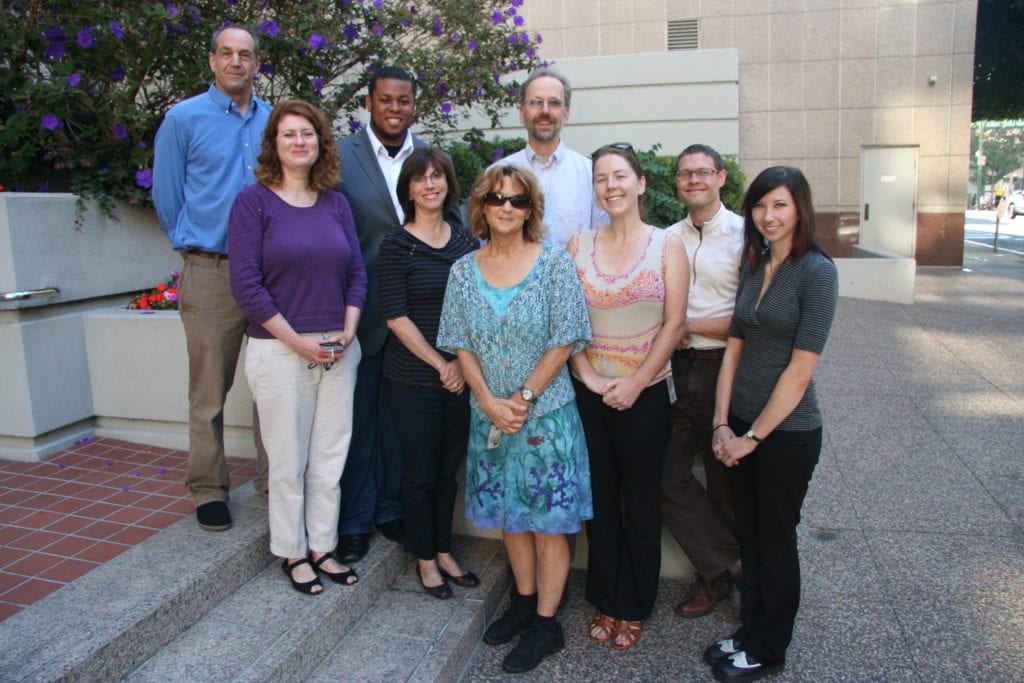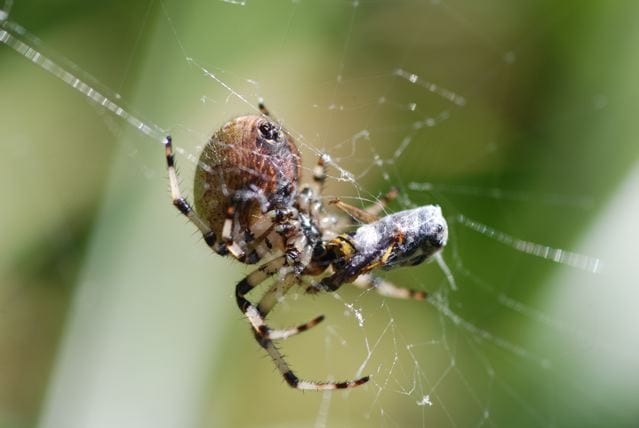
By Murray Schneider, Glen Canyon correspondent
As the summer ended on August 24th, the Feds moved on Glen Canyon at 9 A.M. in the morning. Eight volunteers from the Environmental Protection Agency, wielding loppers and hand saws and camouflaged in work clothes, began combating willow encroaching above a seep adjacent to a boardwalk on the east side of Islais Creek.
Led by Charlotte Ely, 28, who grew up on Martha Avenue, the eight men and women from EPA’s Region 9 Sustainable Water Infrastructure Resource Office joined ranks with three San Francisco Rec and Parks Natural Areas gardeners and seven Friends of Glen Canyon Park volunteers. After reconnoitering a slope dotted with checkerbloom, buckwheat and thistle, they worked for three hours, pushing back colonizing Arroyo willow along a swath of canyon hillside lying just below Berkeley Way and Crags Court.
“Willow follows water along its riparian corridor,” said Christopher Campbell, a Natural Areas Program gardener. “Once grazing deer and elk would eat it, safeguarding hillside grassland.”
The elk and the deer are long gone, as are the Ohlone indians who once hunted both, but intrusive willow continues to creep up canyon slopes.
“We’re not eliminating it, we’re just giving it a haircut,” said Jon Campo, another gardener, mindful that his Natural Areas program both manages and promotes canyon wildlife and diverse plant habitat, utilizing dozens of environmentally conscious volunteers to augment limited Natural Areas personnel.
Gary Fie, a Friends of Glen Canyon Park volunteer, who lives across O’Shaughnessy Boulevard, surveyed the canyon’s expanse of natural wilderness. His job was shoveling armloads of pruned willow branches, butt first, into surrounding bushes. “How do you put a price on all of this?” he said.
“We’re all grazers,” smiled Campo, alluding to the function that grazing deer and elk once would have had.
Another Charlotte, Charlotte Worcester, also a Friends of Glen Canyon Park volunteer, a retired Buena Vista Elementary school teacher, appraised mosaics of spider webs connecting clumps of juncus in the soggy seep.
Campbell watched the former first grade teacher walk gingerly around the plants and smiled too. “Charlotte’s web,” he announced. “Glen Canyon has more plant diversity than any open space in the city,” Campo said to his assembled volunteers.
Unimpressed, platoons of pumpkin spiders continued weaving intricately designed webs in the seep that offers watery sustenance to sedge and spike grass below the hummock where the EPA volunteers sawed at willow limbs.
 Later, after they were done, Ely and her crew left, paralleling the creek and walked to the village, obtaining burritos from La Corneta and poor boy sandwiches from the Canyon Market.
Later, after they were done, Ely and her crew left, paralleling the creek and walked to the village, obtaining burritos from La Corneta and poor boy sandwiches from the Canyon Market.
“Every year or so our office meets to reflect,” said Ely, who has worked for the EPA’s for five years and who graduated San Francisco State University in 2006 with a degree in Environmental Studies. “We discuss the current year’s issues and establish our priorities.”
Ely couldn’t find a better place to schedule an office retreat, which annually revisits its organizational mission statement and goals, then adjacent to a creek that is one of only two above ground streams remaining in San Francisco.
And San Francisco Recreation and Parks couldn’t be more delighted with its greenbelt assistance from Uncle Sam.
Region 9’s Sustainable Water Infrastructure Resource program provides technical support and financial resources to local communities to increase water and energy efficiency and improve wastewater and storm water infrastructure.
“Our role here is habitat restoration,” said Christopher Campbell. “We welcome EPA’s volunteer efforts.”
For Glen Park native Ely, her EPA position is a perfect fit, a dream job. As a child she could leave her Martha Hill home, walk down Congo Street, cross Bosworth at Elk Street and enter the storied canyon where she attended Silver Tree summer camp and later walked her dogs along Alms Road. “The most significant change since then,” said Ely, a Lowell High School graduate, “is the reintroduction of native plants.”
As a child, she reminisced, the 70-acre canyon was often a swamp of impenetratable mud, squishing and sucking at her sneakers. Now, on a sunny August morning above the boardwalk, which was installed by the California Conservation Corp over a decade ago, she and her EPA office mates worked, standing only a few yards above the gelatinous slush she remembered as a 10-year old.
“Mud abatement is another change,” Ely said, pointing to the boardwalk. Above the seep, alongside her colleagues, she wielded a lopper, making pruning cuts under the watchful eye of Campbell, whose supervisory role takes him to other City natural areas such as Mt. Sutro, San Francisco’s most recently opened natural refuge.
Christopher Campbell sometimes dons a maroon T-shirt, which reveals in block letters that volunteers had, over three years, restored and improved 8,700 feet of circuitous Mt. Sutro trails and reclaimed 172,000 square feet of its habitat.
Campbell’s Glen Canyon habitat isn’t all that different from Mt. Sutro’s or even Ely’s own childhood backyard, one of those best-kept San Francisco secrets atop Martha Hill. A two-acre postage stamp of open space, home to song sparrows, a towering eucalyptus grove and 10 different wildflowers including buttercups and irises, Dorothy W. Erskine Park, once part of Rancho San Miguel, is only a stone’s throw from Ely’s Martha Avenue front door.
The parklet hovers over Mangels Avenue and Monterey Boulevard and is named for environmentalist Dorothy Erskine, founder of the Greenbelt Alliance. The hilltop park features a panoramic view that takes in the Bay to the east and farther away, Fremont. Closer to home, the blue Glen Park school looms large and beyond it the spires of Glen Park BART punctuate the skyline.
“My brother and I and other kids from the neighborhood would build club houses and set up swings at Erskine,” said Ely, a place where, even today, blankets of gum tree leaves carpet the ground. “We spent a lot of time there.”
Once part of Glen Canyon, Martha Hill, where a street signs signals Baden Street ends and Martha Avenue begins, is now isolated from its geological sister across Bosworth Street by a speedway of automobiles intermittingly braking to a halt at the foot of Elk Street.
Leaden footed motorist aside, the City is fortunate, according to Ely. “San Francisco is lucky,” she said. “It has more open space per capita than any other place in the United States.”
The EPA’s Region 9, which includes a team of more than 800 engineers, scientists, inspectors, lawyers and environmental specialists, is entrusted with safeguarding California, Arizona, Hawaii, Nevada, Pacific Islands and 147 tribes.
An unabashed cheerleader for the EPA, Ely doesn’t mince many words when it comes to delivering shout outs to her agency, which is housed at 75 Hawthorne Street. “As a result of EPA partnerships with local communities and its grants,” Ely said, “our local water quality is heightened.”
San Francisco has taken advantage of several EPA grants, most recently making use of the San Francisco Estuary Partnership, which facilitated this year’s Bayview neighborhood Newcomb Avenue Streetscape Model Block Improvement Project. The $1.6 million project, which will transform the 1700 block of Newcomb Avenue into one of the most sustainable streets in the City, will replace concrete with new landscaping, plant street trees, and introduce storm water planters and permeable pavers that allow rainwater to permeate into the ground. “Projects such as this enhance ecological integrity,” Ely said, “as well give us peace of mind.”
For a young woman who once played along the banks of Islas Creek, Ely isn’t oblivious to the fact that her Glen Canyon creek enters the bay through the Bay View District. Across the City, where the ocean meets the Sunset and Richmond Districts, Ely is equally as enthusiastic about her agency’s regulatory role, EPA detractor and Texas governor Rick Perry aside.
“Our water division is making efforts to eliminate the waste entering the Pacific gyre,” she said, referring to a 7-millon tons garbage patch of floating plastic waste twice the size of Texas, which emits lethal PCBs, DDEs and DDTs that threaten not only 5,000 square miles of California coastal waters, but poisons the digestive tracts of incalculable numbers of marine sea creatures.
Ely knows how fortunate she is in having attended Discovery Center School, high school and college in the City and to now work now with a federal agency that, among its other efforts, is preventing endangered ocean fish and mammals from eating more plastic than plankton.
But then Ely has her own take on culinary delights. Last year she introduced Modernpast’s owner Ric, not Perry, but Lopez, to the Pacific Coast Farmers Association, the group organizing the Glen Park’s Sunday Farmer’s Market. “I’m thrilled that I can get Bolani there,” she said, recalling the Afghan thin-crusted flat bread filled with potatoes, spinach, lentil and leeks she now buys on weekends.
Charlotte Ely also feels fortunate she can periodically flee the confines of her downtown office, putting into practice at the Glen Canyon ground level what she brainstorms about at her Hawthorne Street high-rise building. “We’re all about helping the environment by performing habitat restoration,” she said. “I want to thank Recreation and Parks for allowing us to get our hands dirty.”

Anyone interested in volunteering in Glen Canyon can e-mail Christopher Campbell at christopher.campbell@sfgov.org or Richard Craib, president of Friends of Glen Park Canyon Park, at richcraib@gmail.com
